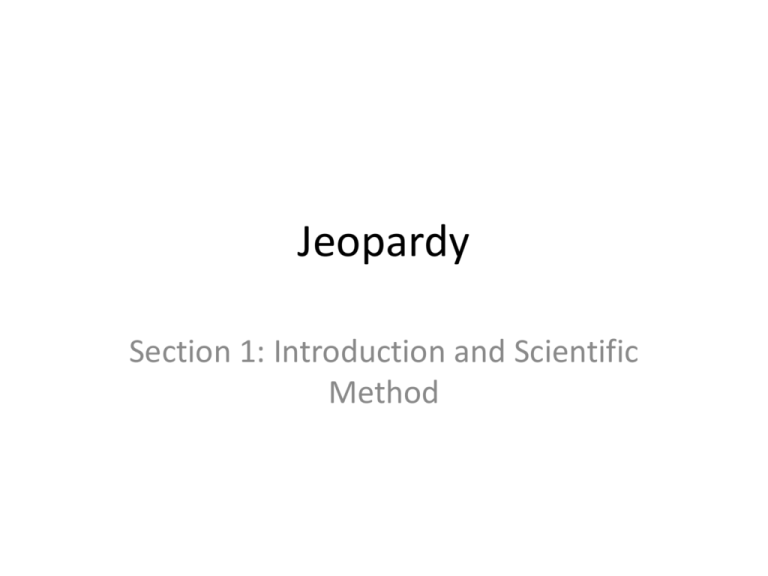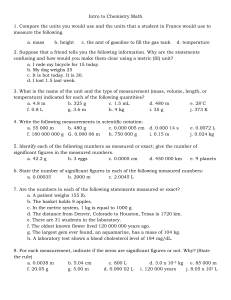Jeopardy
advertisement

Jeopardy Section 1: Introduction and Scientific Method Round 1 Language Definitions Scientific Method Metric System 100 100 100 100 100 200 200 200 200 200 300 300 300 300 300 400 400 400 400 400 500 500 500 500 500 Measurements Language - 100 • This is the first half of a word. Answer: • What is a prefix. Language - 200 • This language is where many roots for scientific words come from. Answer: • What is: »Latin »Greek Language - 300 • This root has the meaning “the study of” Answer: • What is “ology” Language - 400 • This root has the meaning “cells” or “parts of cells”. Answer: • What is “cyto” Language - 500 • This is our definition of science. Answer: • Careful exploration of our natural world to gain knowledge. • Answers may vary. Definitions – 100 • This is anything that may influence the outcome of an experiment. Answer: • What is a variable. Definitions - 200 • This word translates to “Blood-like” Answer: • What is Hemophilia Definitions - 300 • This word translates to “jointed-foot” Answer: • What is “arthropod” Definitions - 400 • This is the measured distance between two points. Answer • What is Length Definitions - 500 • This is the real or true value of a measurement. Answer: • What is the accepted value. Scientific Method - 100 • This is the name of the scientific approach to asking questions and arriving at answers. Answer: • What is the Scientific Method Scientific Method - 200 • This is the step in the Scientific Method between asking a question and making a hypothesis. Answer: • What is: – Research – Observation – Searching for knowledge Scientific Method - 300 • This is the step done after a conclusion is made. Answer: • What is Repeat Scientific Method - 400 • This is what a conclusion is made about. Answer: • What is the hypothesis Scientific Method - 500 • This is the terminology used to describe a hypothesis when making a conclusion. (Must include both positive and negative descriptions). Answer: • What is: – Accepted/Supported – Rejected Metric System - 100 • The powers of ten and decimals are used in this measuring system. Answer: • What is the Metric System Metric System - 200 • In this system of measurement the common unit for measuring length is “the foot”. Answer: • What is the English System Metric System - 300 • This measurement is the amount of matter contained within an object. Answer: • What is mass Metric System - 400 • This is the base unit for length Answer: • What is a meter Metric System - 500 • In the Metric System this prefix for a measurement means 1,000 times the base unit. Answer: • What is “kilo” Measurements - 100 • This is the base unit for mass Answer: • What is a gram. Measurements - 200 • This prefix is used to describe 100 parts of the whole, or dividing the base unit into 100 equal parts. Answer: • What is “centi” Measurements – 300 • This measurement is calculated by dividing mass by volume. Answer: • What is Density Measurements - 400 • This tool is used to measure the average kinetic energy of objects. Answer: • What is a thermometer Measurements - 500 • This process is used to measure the volume of irregular solids. Answer: • What is displacement Round 2 Tools Length/Volume Mass/Temp /Density Variables 100 100 100 100 200 200 200 200 300 300 300 300 400 400 400 400 500 500 500 500 Tools - 100 • This tool is used to measure mass of objects. Answer: • What is a scale or balance Tools - 200 • This tool is used to measure volumes of liquid Answer: • What is: – Graduated cylinder – Beaker – Flask Tools - 300 • The volume of a cube may be calculated using this formula and a ruler. Answer: • What is “s3” Tools - 400 • This is one thing done wrong: Answer: • What is: – Not careful – Read cylinder improperly – Used English System Tools - 500 • This is the density of a rock that has a mass of 4g and a volume of 0.5g. Answer: • What is 8g/cm3 Length/Volume - 100 • This is the amount of space occupied by an object. Answer: • What is volume Length/Volume -200 • This is the base unit used to measure liquid volumes Answer: • What is Liter Length/Volume - 300 • This volume is often called “c.c.” Answer: • What is a cubic centimeter Length/Volume - 400 • This volume is equivalent to 1 cubic centimeter Answer: • What is 1mL Length/Volume - 500 • This is the number of yards in 1 mile. Answer: • What is 1760. Mass/Temperature/Density - 100 • This is the unit for liquid density Answer: • What is g/mL Mass/Temperature/Density - 200 • This describes how tightly packed the particles of an object are. Answer: • What is Density Mass/Temperature/Density - 300 • This is a measure of the average kinetic energy of an object. Answer: • What is Temperature Mass/Temperature/Density - 400 • This is the boiling temperature of water in °F Answer: • What is 212°F Mass/Temperature/Density - 500 • This is the freezing point of water in Kelvin Answer: • What is 273K Variables - 100 • This variable is the one that is measured in an experiment. Answer: • What is the dependant variable Variables - 200 • This variable is manipulated by the scientist and changed in each experimental set-up. Answer: • What is independent variable Variables - 300 • These are all the independent variables not being manipulated, and set at a standard value for every experiment. Answer: • What are control variables Variables - 400 • This variable is plotted on the x-axis of a graph Answer: • What is the independent variable Variables - 500 • This is a replica of the experiment in which the independent variable is left out. Answer: • What is a control experiment







